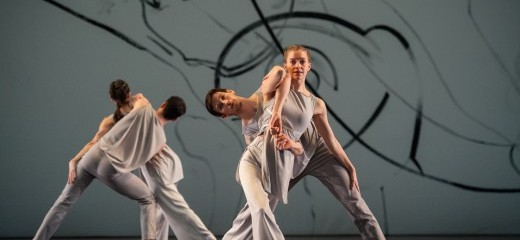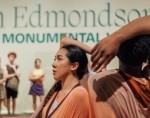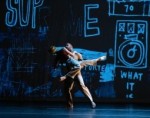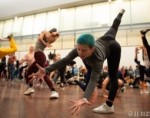
An Astronauts’ Rapacious Night
by Patricia Graham
I don’t know whether to talk in couplets or algorithms after seeing the exquisite film version of Claudio Monteverdi’s opera, L’Orfeo, choreographed and directed by Trisha Brown in 1998.
In the piece’s opening, a simple set consisting of a circle of blue, is projected above the stage evoking dreams of the sky, the moon, portals, domes, and horizons. Trisha Brown company dancer Diane Madden appears within the orb, suspended, floating, and swooping with apparent ease, disturbing the laws of physics in her novel rigging. We ride her gigantic upward pitches and fall with her soft and fearless tumbling descents. Poetic as it may be to embody Musica, an allegorical reference to the spell of music, her performance takes guts and physical fortitude. Although we see the rigging, we don’t catch a whiff of the effort involved from Madden working in precision with the backstage crew.
Andrew’s Video Vault, a monthly film showing at the Rotunda in West Philly, offered up this film of a live L’Orfeo performance, along with input from curators Megan Bridge* and Peter Price. Bridge and Price neatly contextualized the work both before the showing and afterwards, and the intimate audience very naturally continued the dialogue, especially juicy with plenty of insight from former Trisha Brown company member, Lisa Kraus*, present.
Price explained that this very opera, created in 1607, marked the beginning of the operatic form itself. Post-modern dance, on the other hand, evolved centuries later, moving away from the emotion and narrative thrust of modern dance, consciously avoiding drama and exploring the workings of the body itself by means of non-narrative movement that might be called “abstract.” Price spoke of the Baroque and postmodernists as historical bookends in their rendering of performative affect. For me, the space they created together occupied the realm of poetry and vision. The story of Orpheus and Eurydice flowed forward with a movement as slippery as the dancers’. Under Brown’s direction, all of the elements—music, costume, staging, set—were in complete harmony of purpose.
Kraus, curator of the yearlong festival “Trisha Brown: In the New Body,” remarked that this piece used everything Brown had created and experimented with up to this point. What stands out is that Brown never compromised her emphasis on the body, no matter who is on stage. Blurring the line between dancers and singers in L'Orfeo, she achieved a deep integration. Other than the lead characters, the cast is dressed alike in big-shouldered but minimal silky suits and bare feet. The dancers line up, downstage to upstage, then break out with movement that has them alternating places, opening space then closing it, reacting to each other’s shifts in an organic ebb and flow. The patterns repeat and they swing into supported lifts with stretched legs, giving pendular energy to the hips. The singers, too, enact a line pattern and really get it moving, slipping in and out of their spots in succession. They run three abreast like teams of horses, with a little help from the dancers—part game, part task.
Brown sets up patterns and works them throughout the piece: repeating, varying, enlarging—a minimalist ode. The work is unexpectedly evocative in its abstraction. The chorus has a matter-of-fact repeating pattern of hand gestures—bent elbow, one hand moves bent arm, open hands with outward palms connect at wrists and revolve. This is them. This is what they do. I loved seeing an opera staged around what the body actually does, rather than a historical gesture in space, encoded to mean something other than what it appears to be.
Slain with delirium at the impossible beauty of it all, I am firmly convinced of the sense of many non-sensical things.
The music, which includes many historical lute-like stringed instruments, is crunchily percussive in a well-tempered way. The singers provide total sonic satisfaction. The King of Hades has a very romantic life with his abducted Queen; they lounge in perfect poise on the electric green rim of a sky-hung orb, watching the tragedy of Orpheus unfold. Orpheus, overcome with joy at the chance to regain Eurydice, blatantly boasts of the power of his lyre (his music). No, Orpheus! It was the power of love between the rulers of Hades, love even in the kingdom of Hell.
And yet, as the darkly formidable world of Hades slowly rolls away, our gaze is drawn—up, up, up—and there is Musica, a tiny figure, pushing back the night.
__
*Full disclosure: Megan Bridge and Lisa Kraus have served as Directors of thINKingDANCE.net as well as writing and editing for the site.
L’Orfeo, a film of the Opera by Claudio Monteverdi Directed and choreographed by Trisha Brown, Andrew’s Video Vault, The Rotunda, March 10, 8 pm, ARMcinema25.com
By Patricia Graham
April 11, 2016










